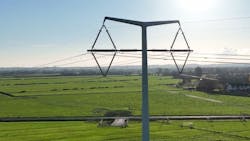National Grid Energizes T-Pylons
National Grid has successfully energized 36 of the world’s first T-pylons between Bridgwater and Loxton in Somerset. The new shaped pylons have been constructed as part of the £900 million Hinkley Connection Project, a new 57 km high-voltage electricity line that will connect six million homes and businesses to new sources of home grown, low carbon energy and help the UK to meet its net zero by 2050 target.
High-voltage electricity – up to 400,000 volts – is now passing through the T-pylons, a newly constructed electricity substation at Sandford and 8.km of underground cables through the Mendip Hills Area of Outstanding Natural Beauty. A further 80 T-pylons will be completed and energised by 2024.
Construction of the first T-pylons began in September 2021, with all the conductors or wires that transmit the energy between Bridgwater and Loxton installed by March 2022. The conductors are now energised and transporting electricity around the National Grid’s electricity network.
The T-pylon design, the first major UK redesign since 1927, has a single pole and cross shaped arms, and is around a third shorter than traditional high-voltage pylon design with a smaller ground footprint. The new design was selected from over 250 designs entered into an international competition run in 2011, organised by the Royal Institute of British Architects and government (the then Department of Energy and Climate Change). With a need for new energy infrastructure to enable progress towards net zero, the competition sought a new design to reduce impact on the local environment and surroundings.
Along with offshore routes, underground cabling and continued use of traditional lattice pylons, the new T-pylon design is a potential technology choice for future projects. Each new transmission network project is assessed on a case-by-case basis, with the technology used by National Grid based on planning policy and regulations set by Ofgem as well as engineering, environmental and cost considerations.
“The T-pylons are now reinforcing and strengthening the network in the South West and are ready for the connection of low carbon energy when Hinkley Point C starts generating," said Steven Haskayne, project director for National Grid. “This new design forms part of our significant investment in the network in England and Wales, adding capacity onto the grid to deliver low carbon electricity to millions of people across the UK to use for years to come, and helping the UK’s journey toward net zero.”
